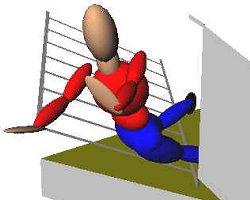Biomechanics is the application of mechanics to the interaction of biological systems with their external environment. When investigating an accident, biomechanical analysis can be used to reconstruct a victim’s motion and relate it to his injuries. This can be applied in such diverse cases as determining the post-impact motion of occupants involved in an automobile accident, or calculating the impact force of an elevator door closing on a person’s knee. A biomechanical analysis may be accomplished with simplified stick figure models or complex 3D computer simulation techniques.
Biomechanical engineers often serve as expert witnesses, or create computer simulations and accident reconstructions for use in injury litigation.
Our engineers have been assisting attorneys and insurance representatives in investigating accidents since 1990. We have a highly qualified staff of engineers with advanced degrees from top-tier universities who have provided testimony on behalf of both plaintiffs and defendants at trial
